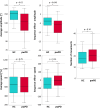Neural correlates of bradykinesia in Parkinson's disease: a kinematic and functional MRI study
- PMID: 39242570
- PMCID: PMC11379907
- DOI: 10.1038/s41531-024-00783-2
Neural correlates of bradykinesia in Parkinson's disease: a kinematic and functional MRI study
Abstract
Bradykinesia is defined as a "complex" of motor alterations including decreased movement amplitude and/or speed and tendency to reduce them with movement repetition (sequence effect). This study aimed at investigating the neural and kinematic correlates of bradykinesia during hand-tapping in people with Parkinson's disease (pwPD) relative to healthy controls. Twenty-five pwPD and 25 age- and sex-matched healthy controls underwent brain functional MRI (fMRI) during a hand-tapping task: subjects alternatively opened and closed their right hand as fully and quickly as possible. Hand-tapping kinematic parameters were objectively measured during the fMRI task using an optical fibre glove. During the fMRI task, pwPD showed reduced hand-tapping amplitude (hypokinesia) and a greater sequence effect. PwPD relative to healthy controls showed a reduced activity of fronto-parietal areas, middle cingulum/supplementary motor area (SMA), parahippocampus, pallidum/thalamus and motor cerebellar areas. Moreover, pwPD showed an increased activity of brain cognitive areas such as superior temporal gyrus, posterior cingulum, and cerebellum crus I. The decreased activity of cerebellum IV-V-VI, vermis IV-V, inferior frontal gyrus, and cingulum/SMA correlated with hypokinesia and with the sequence effect. Interestingly, a reduced activity of areas involved in motor planning and timing correlated both with hypokinesia and with the sequence effect in pwPD. This study has the major strength of collecting objective motor parameters and brain activity simultaneously, providing a unique opportunity to investigate the neural correlates of the "bradykinesia complex".
© 2024. The Author(s).
Conflict of interest statement
E.S., A.G., L.Z., D.E., R.B., A.G., S.B., C.T., E.C., M.M., E.P., and M.A.V. declare no financial competing interests. D.C. is recipient of a grant form the Italian Ministry of Health. M.F. is Editor-in-Chief of the
Figures



References
Grants and funding
LinkOut - more resources
Full Text Sources

